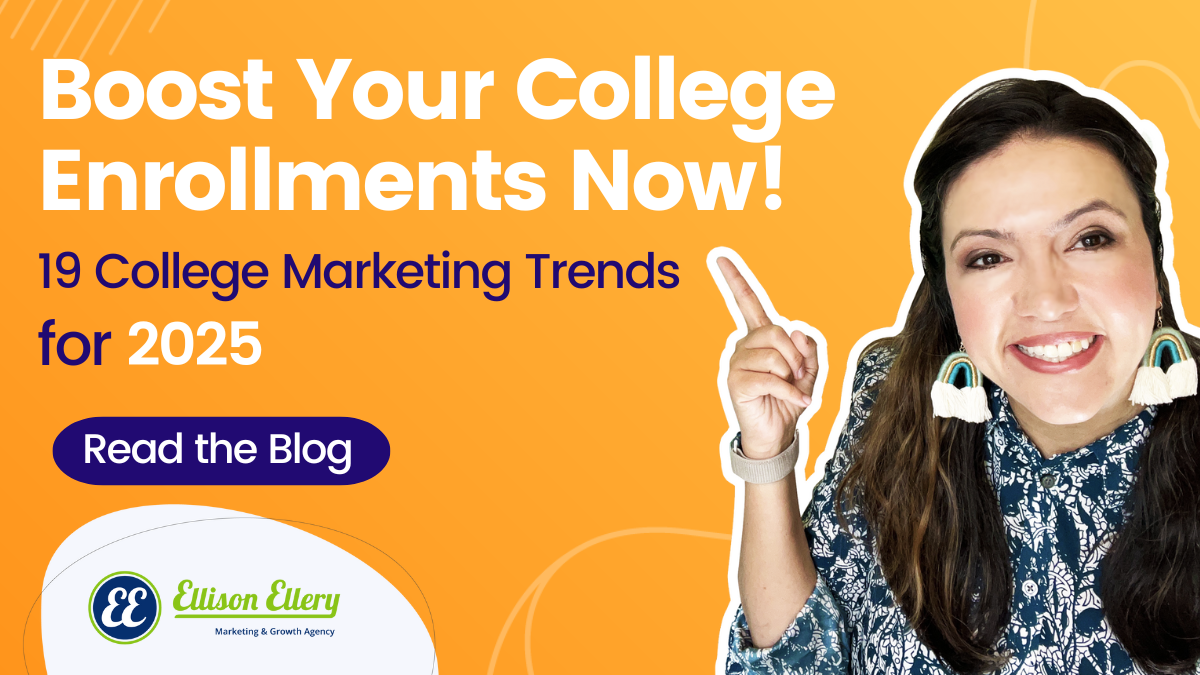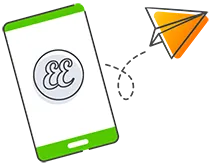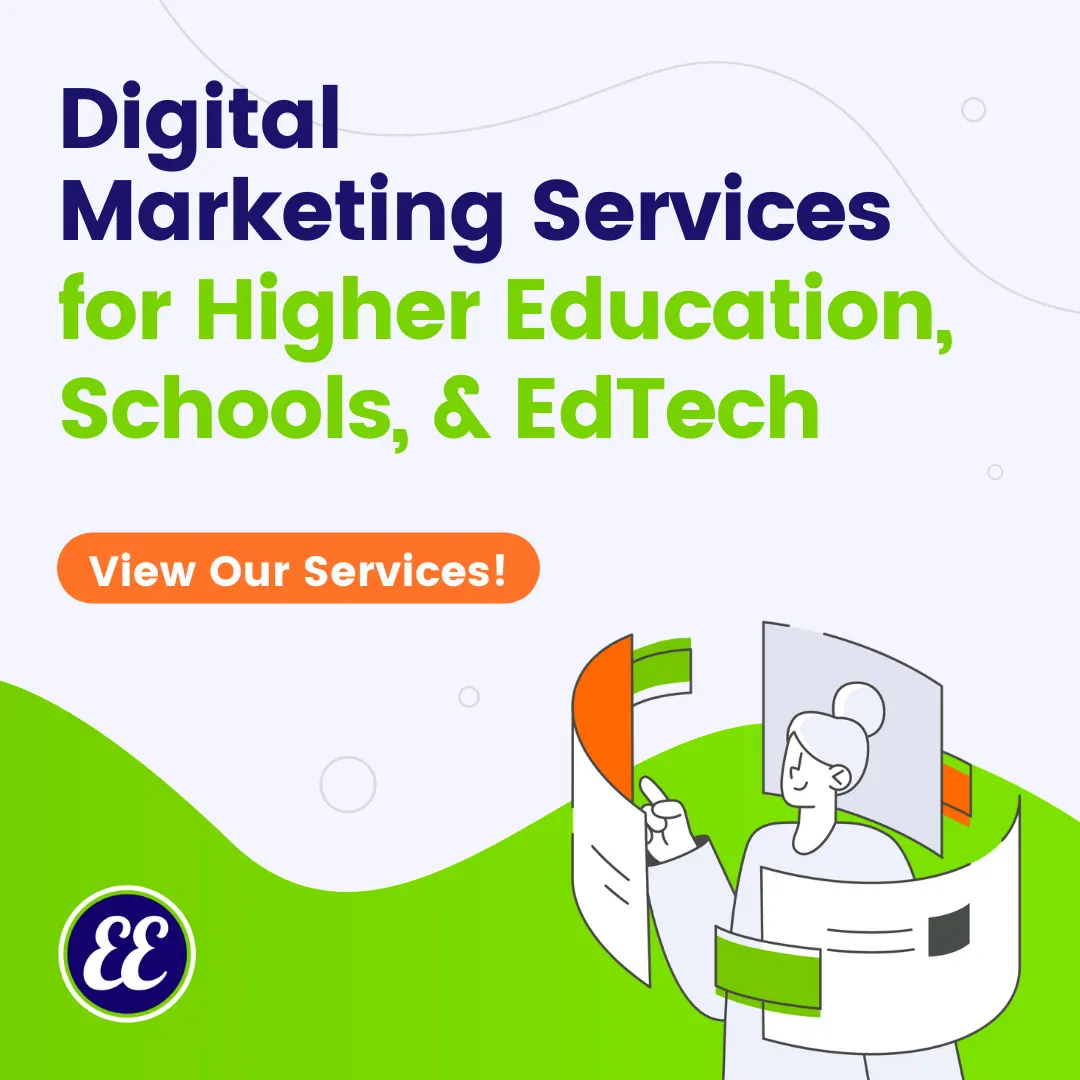Why You Should Care About College Marketing Trends in 2025
The enrollment journey is more complex and competitive than ever. Prospective students are navigating clunky websites, unclear messaging, and hard-to-find enrollment information, leaving many feeling frustrated enough to give up entirely.
For 2025, the mission is clear: simplify and personalize your enrollment process. Universities must eliminate barriers and create seamless, student-centric experiences that foster trust and engagement from the first interaction.
How can your school adapt? By embracing digital transformation, investing in innovative solutions, and adopting collaborative strategies that break down internal silos. Here are the top trends shaping higher ed marketing in 2025:
Think: new year, new you(niversity).
If you’re struggling to keep up with all the trends, no worries. We’ve got you covered.
In this post, we’re sharing the top 19 college marketing trends you need to know in 2025 and how your college can start taking advantage of them.
Table of Contents
Why Should You Care About College Marketing Trends in 2025?
The enrollment journey has become increasingly complicated and frustrating for prospective students to navigate.
The combination of difficult website experiences, unclear messaging, and hard-to-find enrollment information is enough to make any prospective student throw their hands in the air and call it quits with your school.
Your goal for 2025? Work on removing the hurdles in your enrollment process. Make it easier to enroll at your university!
Your school will need to lean further into digital transformation than ever before via flexible, nimble models without silos — collaboration is key in developing an effective digital transformation plan.
We’re expecting to see new waves of innovation and experimentation among many universities as they recalibrate their relationships with prospective students by:
-
- Crafting new experiences
-
- Implementing targeting methods
-
- Ensuring hassle-free enrollment journeys.
Brands that create meaningful, authentic engagements with prospective + current students will achieve lasting connections with their students, alumni, and donors.
So, what do you say? Are you up to the challenge?
Let’s dig into the college marketing trends your school needs to investigate in 2025.
1. Rising Media Costs: Start Tracking Everything
Media costs will continue to go up in 2025. Why?
As more and more universities adapt to the modern market by creating online degree programs, higher levels of competition are driving prices up on advertising platforms like Facebook.
The problem is exacerbated by the fact that higher ed institutions aren’t the only ones flocking to these online advertising hubs — the digital transformation is happening across industries, from B2B to e-commerce.
So, it’s imperative your school starts tracking your marketing spending and other activities more closely.
Specifically, start tracking your spend on:
-
- Cost-per-inquiry
-
- Cost-per-application
-
- Cost-per-start
-
- Cost-per-retained student
It’s also important to take a closer look at your departments, specifically Enrollment and Financial Aid. If any of your departments are causing unnecessary hurdles, you risk losing prospective students’ tuition dollars.
For Enrollment, take a closer look at your staff’s outbound efforts (phone calls, talk time, results) to see how well they are engaging with prospective students and moving them along the enrollment process.
Since Financial Aid can also be a huge hurdle for many prospective students, you also need to track how many people go into Financial Aid and how many come out.
Invest in Better Marketing Tracking: Attribution
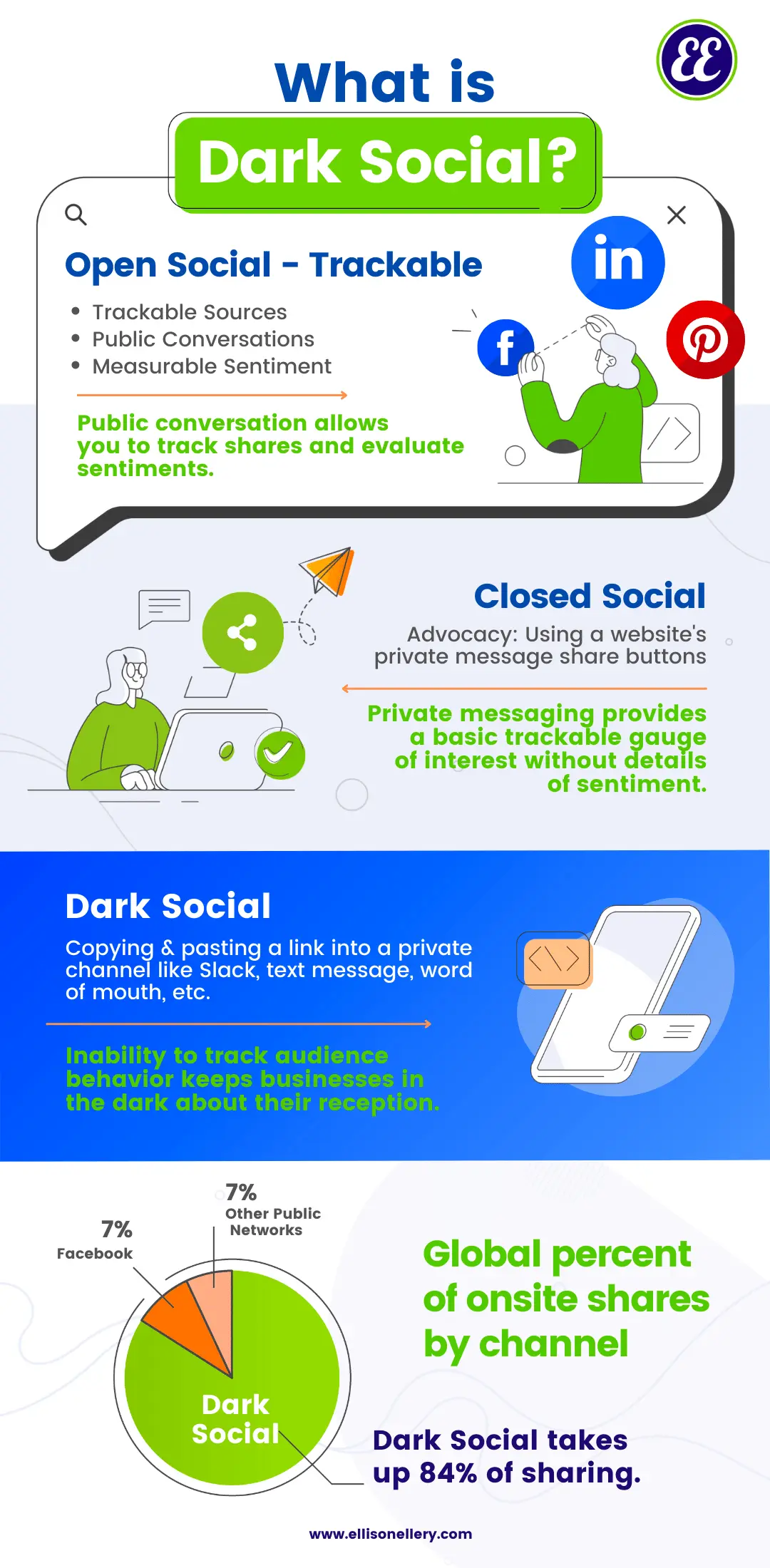
First off: what’s attribution?
Attribution means assessing the value or ROI of the channels you’re using to connect with prospective students (e.g. social media, ads, email marketing, etc.).
For example, you may be running display ads and those ads are helping to drive you more brand awareness, so you need to attribute some of your organic brand searches to the amount you spend on display ads.
The same is true when your brand does more thought leadership. While someone may not click from your thought leadership post on LinkedIn or a steller video on YouTube, this person may still have been impacted by it and will later come back to your brand to request information or he or she may do a branded search later for you.
Why go through the extra steps to set up attribution?
If you don’t institute better marketing tracking and attribution then you run the risk of turning off channels and stopping marketing tactics that are driving you new enrollments or making other channels more effective.
There is a whole classification of marketing called dark social.
The term “dark social” is kicked around every so often by marketers. But what is dark social, how does it affect your brand, and how you can measure it?
Not every piece of marketing or communications can be attributed.
According to studies, as much as 84% of brand shares are made without a brand being able to track and attribute where they came from.
For example, if someone asks for a recommendation or referral through text message, word of mouth, Slack, Facebook, LinkedIn message, Facebook closed parent groups, these types of communications can’t be tracked by a brand.
Think of how many times parents ask each other questions about which college is right for them, how can your college or university increase awareness so it can be in the consideration set?
Look into third-party attribution tracking companies that can help you better track your results down the funnel, but know that a large percentage of word-of-mouth conversations are not able to be attributed, but are valuable.
Here are a few attribution companies to get you started:
Marketing that can be valuable for your growth, but historically difficult to attribute an ROI to:
-
- Communities & Groups (Slack groups/channels, Facebook groups, Discord, Reddit, etc.)
-
- Content Platforms (Podcast, Spotify, YouTube, etc.)
-
- Social Platforms (LinkedIn, Instagram, Reddit, etc.)
-
- Direct Word of Mouth (DMs, text messages, Zoom calls, school counselors, etc.)
-
- Branding & Storytelling
-
- Working with Influencers and Content Creators
-
- 3rd Party Events & Meetups (Campus tours, school visits, etc.)

Modernize your enrollment process.
Schedule a free, no strings attached 30-minute consultation to find out how we can optimize your college’s enrollment journey and drive more qualified prospective students into your enrollment funnel.
2. Lead Nurturing: Personalized Email Marketing

Right now, your school’s website probably has a “Request More Information” link/button that may or may not be buried.
If your efforts are a little more sophisticated, you may have lead generation pages with short-forms.
No matter how the inquiry gets into your system, it’s important that your school nurtures that inquiry.
An effective email marketing strategy is one of the most powerful nurturing tools! On average, every $1 spent on creating a personalized email marketing plan generates a return of $42.

Most schools create a few emails and then move onto other projects — don’t be that school! Your team needs to cultivate your email marketing strategy to convert as many inquiries into enrollments as possible.
Once a potential buyer subscribes to your email list, you have much more control over what they see from you. Plus, it’s easier to measure your progress because you can see how any given prospective student responds to your campaigns and even market to them based on those interactions.
But you can’t just blast out emails and expect the dollars to start rolling in.
Here’s what you have to do to make your emails powerful:
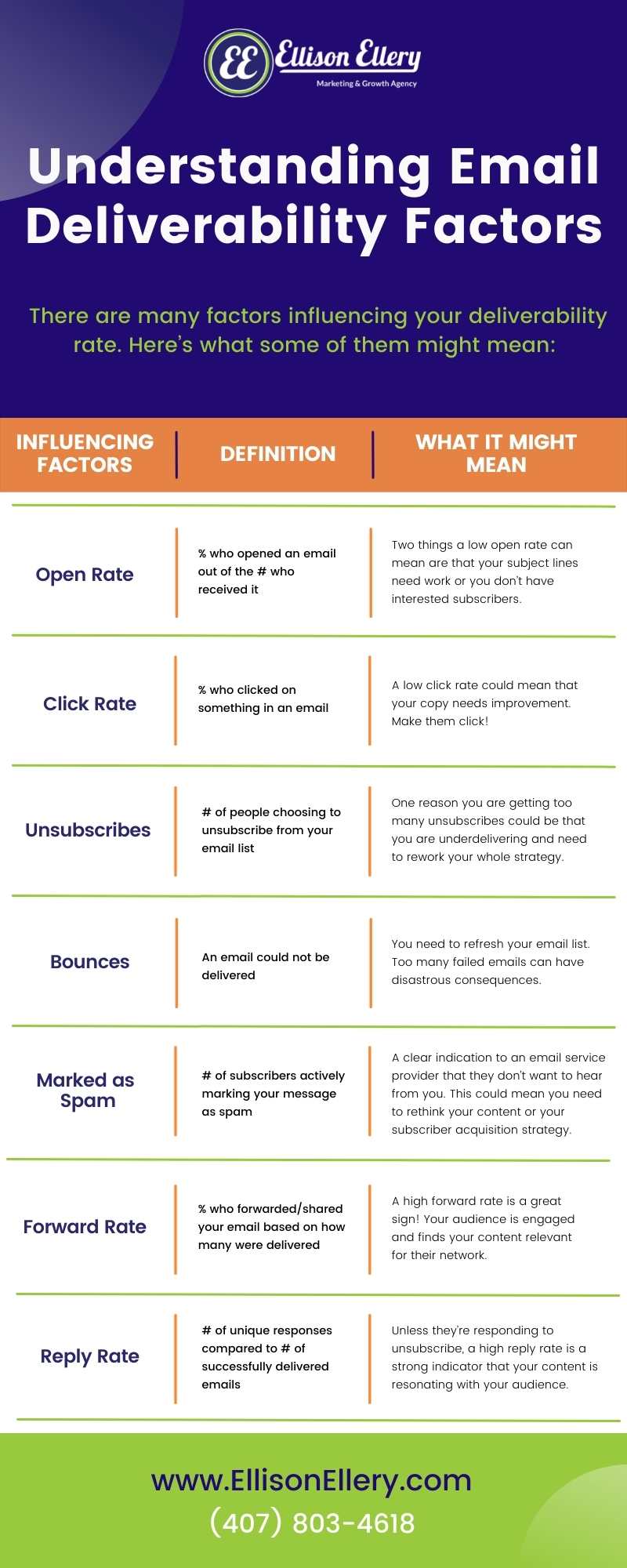
Send Personalized Emails
Attention has become a hot commodity — and no one wants to dedicate their attention to generic email blasts from faceless corporations.
The way to actually get prospective students’ attention? Personalization.
In short, personalized emails use prospective students’ data (location, interests, activity on your website, etc.) to provide them with more relevant information.
Personalization can be an exhausting endeavor, but it works!
Making the extra effort to personalize content guarantees a much bigger ROI and is better for building trust in your brand.
Be More Personal
And personalization can extend beyond harnessing data — try adding more personality to your emails!
One way your university can start being more personable is by using emojis in your email subject lines! You’re not selling to a data point — you’re selling to a real live person.
According to Campaign Monitor, businesses using emojis in their emails can see up to a 56% increase in their unique open rates.
Ask your students to take your emails out of the promotions tab!
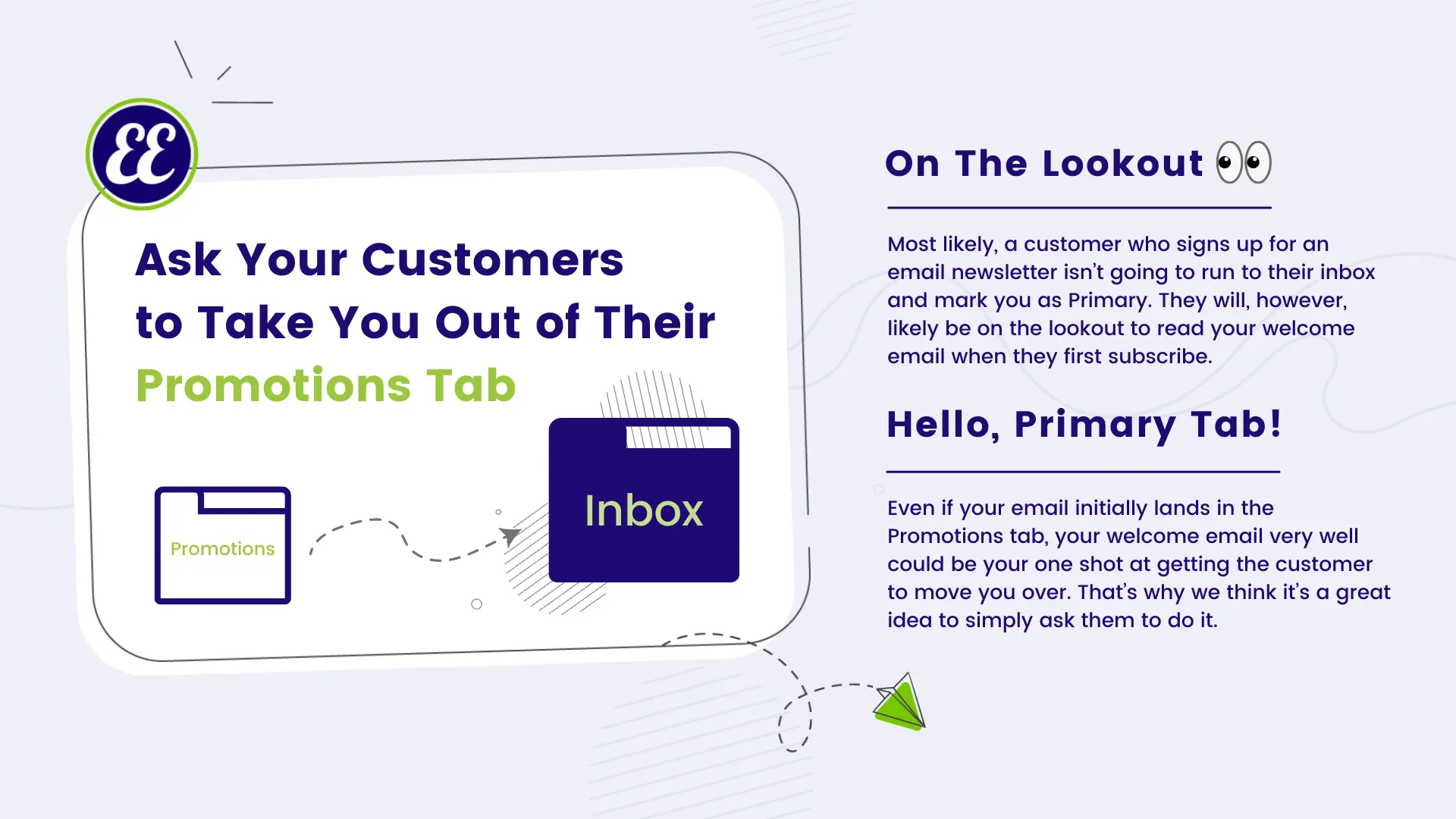
3. Ad Strategy: Invest in OTT Ads
If you’re not familiar with OTT (Over-The-Top) ads, that’s okay — OTT ads allow you to reach prospective students while they stream television shows and movies. (Think Hulu!)
BIA Advisory Services forecasts that, in 2022, OTT will reach $2 billion in ad spending targeting local viewers, making it one of the fastest-growing local ad platforms.
OTT ads are one of the top college marketing trends in 2025 because they help improve your reach and allow you to target specific audiences.
Dan Robbins, VP of Marketing & Partner Solutions at Roku, says:
“In 2022, the shift into the streaming decade will expand. Viewers are streaming more and tuning less than ever before – one in three American homes no longer have traditional pay-TV. Marketers will accelerate efforts to follow consumers into TV streaming. Next year, this focus will include new ways to surprise and delight consumers beyond the traditional TV spot, to avoid ad collision that harms the brand building, to measure actual lift to product sales or signups, and to test commerce on the TV screen.”
Universities are now able to use modern machine learning technology to measure and optimize campaigns across OTT, Linear, Streaming TV, and Digital Audio.
The higher education industry is in a state of constant change, and technology lifecycles are shortening — early adopters are usually rewarded for taking advantage of new solutions (like OTT ads!) rather than relying on antiquated systems and legacy technology.
4. Content Strategy: Act Like a Digital Native
If you’re producing content without a strategy: stop!
The most effective and high-performing content comes from a well-thought-out content marketing strategy.
In the meantime, here are 4 elements that need to be included in your content strategy in 2025.
Note: it’s not enough to simply be on the most popular online platforms. You need to invest time into learning how they work and what’s popular so you can act like a digital native. And, if your student population is around or under the age of 35 then your students and prospective students are digital natives, whether they are some of the youngest millennials or oldest Genzers.
Read to learn about how to best market and recruit GenZ and how to win them over.
Colleges and universities need to drastically improve their content strategy.
We can’t stress the importance of having a good content strategy enough❗️
You can have the best-designed and well-written content in the world, but if it isn’t backed by an intentional content strategy, the results won’t live up to the work you put into the creation process.
The route to success with your content strategy is to pay super close attention to your prospective students.
What are their pain points, and motivations, and what does the buyer’s journey look like for them? 🛍
Watch this Video to Learn More About Developing a Stronger Content Strategy
We’ve created several thought leadership articles around content strategy:
Video Content
Your university needs to start harnessing the power of video marketing.
Here’s why:
-
- Viewers retain 95% of a message when they watch it in a video (compared to 10% when reading it in text).
-
- Social media posts that contain a video have 48% more views than those that don’t.
There are all types of videos your university should be creating! If your staff, whether it’s admissions, financial aid, or student support are receiving the same type of questions often, then that means you need to create a video explaining the answer to this question.
This question keeps showing up because the student or prospective student cannot find the answer to this question easily, on your website. Students don’t want to speak to your staff, they would rather get their questions answered quickly without the horrible run around of being bounced from person to person. Use video to get your students these answers when they want them, whether that’s 2 am or 2 pm.
Once these videos are created, be sure to leverage them and let people know where to find these videos. Here are some recommendations on how to leverage these videos:
-
- Email campaigns
-
- Application pages/ “thank you”pages
-
- Social media
-
- SMS/MMS Text messages
-
- Program pages
-
- Student Portal
-
- Faculty share them
Video Storytelling:
UCLA also features some fabulous videos on its YouTube channel that are rich in storytelling. As mentioned above, these videos further strengthen their brand and help to drive their future enrollments. I bring this up because I am rather impressed by UCLA! Check out more examples of rich video storytelling.
Storytelling can also be done through student stories, tours of your classrooms, clinical rooms, and so much more.
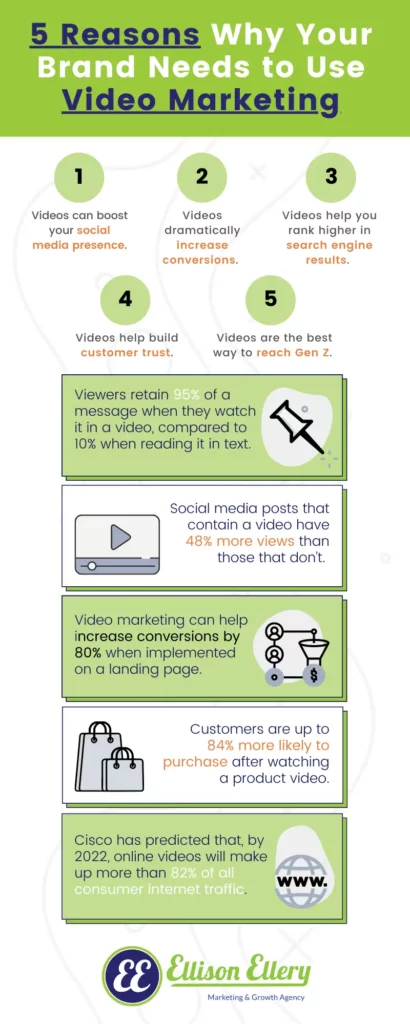
Edutainment
Edutainment (education + entertainment) is incredibly important when it comes to your advertising strategy.
The benefits of edutainment ads? You’re able to inform your prospective students in an entertaining way. Edutainment can help to increase conversions, trust, and affinity for your school and can be used all throughout the enrollment journey,
Whether it be a “how to apply” tutorial or a FAFSA walkthrough, try to find ways to answer your prospective students’ questions while also entertaining them.
Remember: on average, you only have 3 seconds for your ads to catch someone’s attention. Edutainment (done right) is one of the best ways to break through the clutter.
While this ad is loaded with entertainment, watch closely as you learn a lot about how Chatbooks works, but you probably do not mind learning more about how to buy this product because you are entertained. Would you watch an entire video on how Chatbooks works if you weren’t entertained?
Probably not.
TikTok
We don’t have to tell you TikTok is wildly popular — you probably already know.
Here’s the numbers to back it up:
-
- TikTok currently has over 1 billion users worldwide
-
- TikTok is projected to reach 1.5 billion users by the end of 2022

Staying off of TikTok isn’t doing your school any favors. If you want to connect with your prospective students, meet them where they’re at.
And invest time into actually learning the platform — don’t just create the content you already know how to create and hope it’ll work. Follow the trends!
Learn more about TikTok’s growth projects and about how to create a TikTok proven growth plan.
Check out Miss Excel on TikTok with over 735,000 followers. She provides Microsoft Excel tips. Seems doable 🙂
Need some inspiration? Check out these Universities that are killing it on TikTok!
Continue creating reels and posting stories to break through the algorithm and get noticed. (And if you aren’t already, now is the time to start creating short-form reel content, similar to TikTok.)
Instagram added a link sticker you can add to your Stories that everyone can use. (Link stickers were previously reserved for verified accounts or accounts with a certain amount of followers.)
Meaning, you can link directly to your school’s most important pages directly from Stories, whether it be your application form, scholarship info, blog posts, or any other relevant offer.
Learn more about current Instagram trends.
5. Brand Awareness: Create a Brand Connection with Prospective and Incoming Students
One of the best ways to increase your school’s brand awareness is to make your brand more visual.
Or, as the kids would say, make your school more “Instagrammable!” Create content and branding visuals that your prospective and current students actually want to reshare on social media.
Delight students and parents with “Instagrammable” moments like over-the-top acceptance packages or branded welcome kits. These moments can turn students into natural ambassadors for your brand.
How? One option is to create an over-the-top acceptance package. Sure, you can throw some fun things in an acceptance envelope, but an acceptance package takes things to a whole new level. Think of all of your future unboxing videos and opportunities to show up in people’s social media feed. It builds credibility and trust if the student is sharing your university to their friends and family; move more of those display ad dollars and try this instead.
Here are some examples of schools killing it with their acceptance packages:
University of the Ozarks + Saint Leo University

University of the Ozarks prominently displays their school colors in their acceptance package plus gives away some free things students will actually use!
Saint Leo University creates a strong visual moment by boldly displaying its lion logo.
Florida Polytechnic University
Florida Polytechnic University knows how to capitalize on trends. By including a branded PopSocket in their acceptance package, they’re ensuring newly accepted immediately become brand ambassadors since it’s a near guarantee they’ll want to try out their new PopSocket.
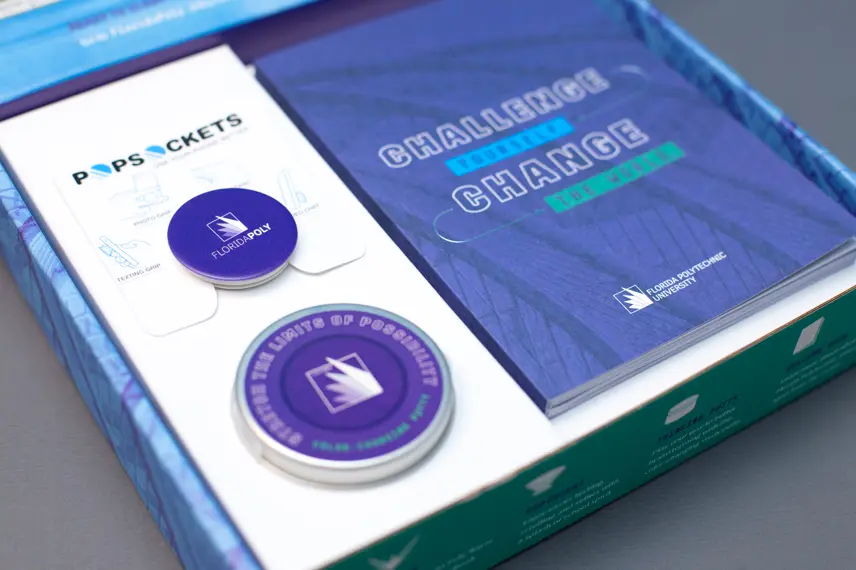
UCLA
UCLA does some amazing things for it’s students! Notice how they sent people their graduation tassels. this helps students envision their end goal of graduating. How powerful is this message??
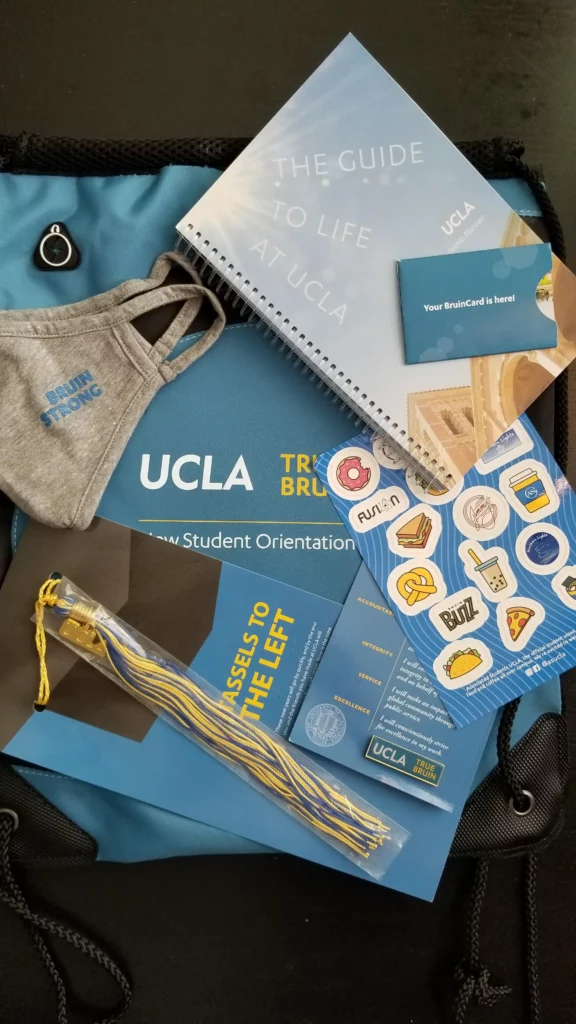
UCLA also capitalizes on trends in their new student welcome package by including stickers and a branded mask — what student wouldn’t want to share this collection on their social media?
Winthrop University

Finally, you should consider including a branded acceptance poster in your school’s acceptance package. Giving your students the opportunity to snap a picture holding up a bold, aesthetic poster is much more effective for your brand awareness than simply sending them an acceptance letter.
Creating delightful moments for your students has a broader benefit: if you create unique visual moments for your students (like with an acceptance package), they’ll want to share it on social media.
…which means they’ve just now become some of your strongest brand ambassadors.
Investing in your brand’s visuals doesn’t just create a special moment for students — it’s also a powerful way to market to prospective students.
6. Give Students a Self-Service Enrollment Experience
Last year, 28% of students said that they did not visit any college prior to enrolling.
For the class of 2023, only 45% of students said they are very likely to visit a college campus this academic year.
If your school is relying on in-person tours to do the heavy lifting in your enrollment journey, you may need to rethink your strategy.
Instead of relying on tours, start building out more engaging self-service enrollment experiences online. Data supports the idea that today’s students (between Covid and the explosion of all things digital ) are starting to favor a comprehensive online enrollment journey.
And the self-service aspect of an online enrollment experience is absolutely key — today’s students want to get the job done while encountering as few hurdles as possible.

For example, 70% of people would rather choose a “Message Us” button over a “Call Us” button when looking for support. How does this tie into higher education? Prospective students don’t want to commit to too much, too fast with your school.
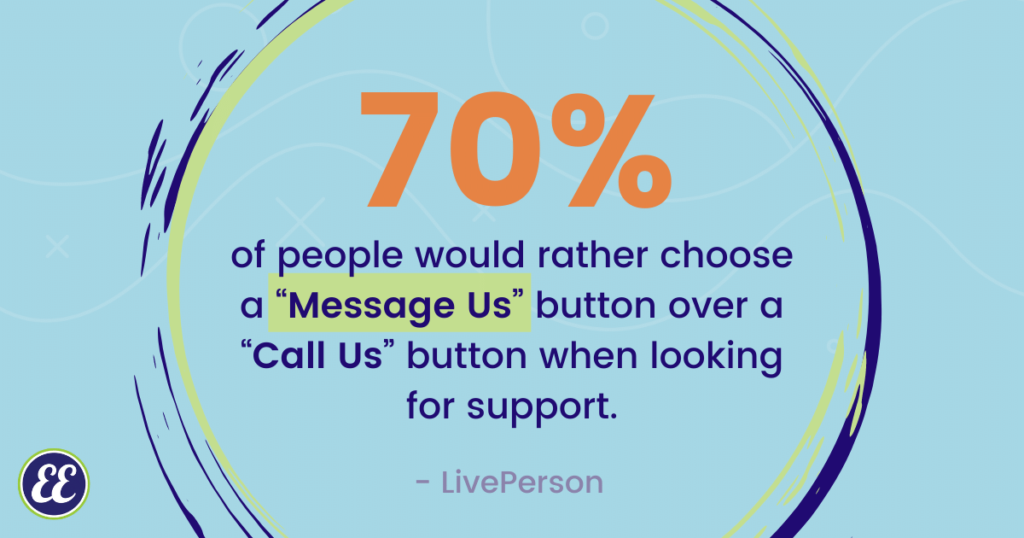
Give prospective students options to get the answers they need at their own pace. Meaning: filling out an application shouldn’t be your school’s main call-to-action.
Develop and clearly display other low commitment calls to action that give prospective students a chance to provide you with their email and phone number so you can begin the process of nurturing them.
Use Video to Help You Create a Great Student Self-Service Experience
As mentioned above, use videos to help provide your students with a self-service experience.
Create a video library answering your student’s most pressing questions. Check out Home Depot’s video library. They have one for their pros and one for DYI. The one for their pros includes how to use their system. Use these examples as a blueprint for creating your video content library.
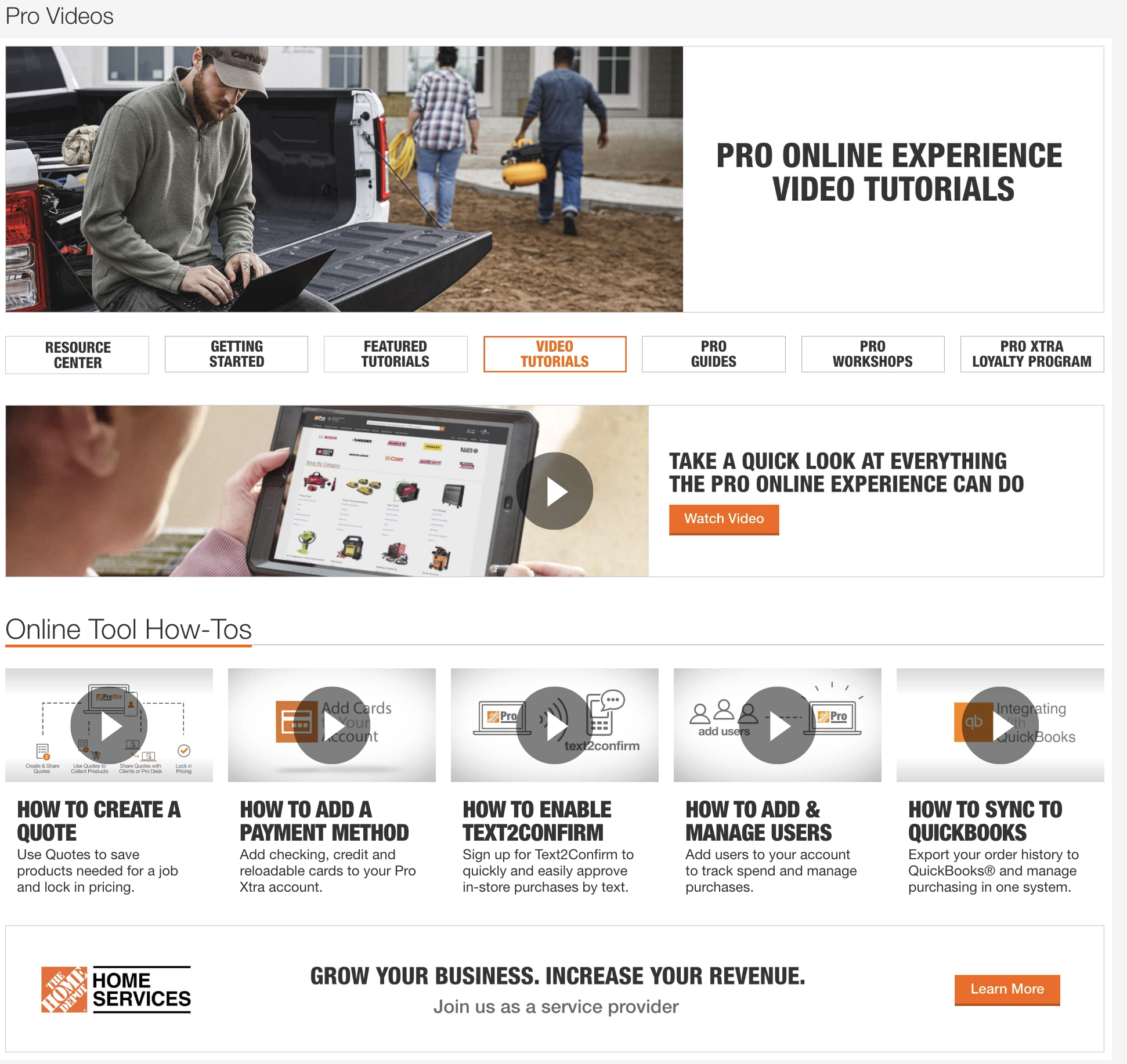
7. Use a CRM so No One Falls Through the Cracks
How Do You Pull these Prospective Students into the Enrollment Process?
One of the best ways to help marshal people through your enrollment process is with a higher education CRM. A CRM system allows you to capture the person’s information in real-time and kick-off a set of marketing and enrollment automation.
This marketing automation takes some work to set up, but then it will continue working on weekends, after hours, and over the holiday break. These automations can help your small, but mighty Admissions team do so, so much. Your team will be able to personalize the enrollment process at scale, 24 hours a day, 7 days a week.
When someone comes to your website to learn more about your institution, he or she wants to learn more about your school immediately and NOT a day or two later.
This is important and worth auditing your current process. Prospective students now expect immediacy. If your enrollment process can’t provide this, let’s chat.
Is your school able to communicate with prospective students immediately?
Do you have your enrollment journey mapped out?
You can put a prospective student on a communication track with a combination of text messages, emails, phone calls, and messenger communications.
You can, and should, personalize these communications and ensure that no inquiry falls through the cracks.
Your CRM can help you track what channels inquiries came from, so you can double down on what is working and eliminate those channels that are not working.
A CRM doesn’t need to be expensive to work! However, even the most expensive CRM will not provide you with enough value if you do not layer in the right strategy and automations on top of it.
When looking for a system, it’s important to make sure it will integrate with your student information systems (SIS) as a first step. It’s also important to make sure you find a solution that allows you to send 2-way text messages, auto-dialing (if possible), send out videos via email and text, and as an added bonus, no-ring voicemails.
According to the book, Who Gets in and Why, 9 out of 10 colleges buy contact lists of high school sophomores at up to $.45 a contact. If your college buys prospective student lists, it is imperative your college set up a lead nurturing strategy to stay in contact with these young prospective students and continue to build value for your college or university over time.
If you set up your CRM correctly, you can ensure no inquiries fall through the cracks and that people are progressing through the funnel at a reasonable rate.
8. Why Your University Needs Text Messaging
SMS is the most preferred way for billions of people to communicate, including your students and prospective students.
Why it’s an imperative for your institution to add text messaging to your enrollment strategy:
-
- 95% of text messages are read within the first 3 minutes after they are received.
-
- Short text message open rate is nearly 98%, in comparison with the email – open rate is 22%.
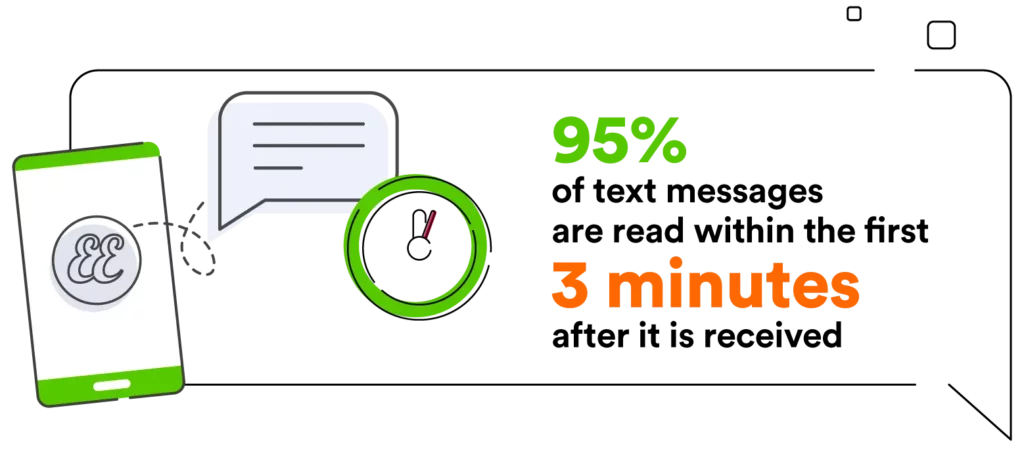
SMS is the most preferred way for billions of people to communicate, including your students and prospective students.
Why your institution must add text messaging to your enrollment strategy:
95% of text messages are read within the first 3 minutes after they are received.
Short text message open rate is nearly 98%, in comparison with the email – open rate is 22%.
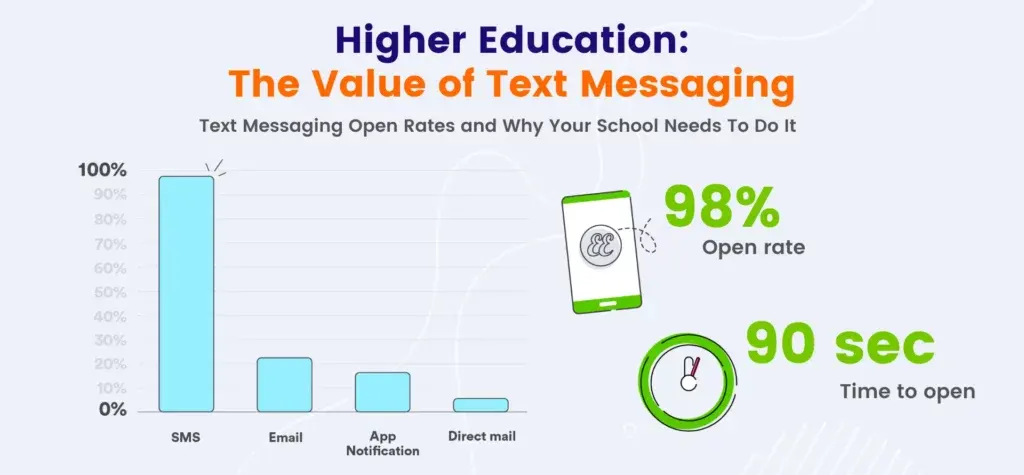
You can run the following types of SMS/MMS Campaigns:
-
- Brand building (what makes your campus or school special?)
-
- Links to virtual campus tours
-
- Video testimonials
-
- Video highlights of what makes your school special
-
- Automatic reminders (reduce your Admissions no-shows!!)
-
- Campus activity notifications
-
- Automated enrollment documentation that needs to be completed including Financial aid
-
- Appointment confirmation and follow-up
-
- Campus event notification and invitations
-
- Retention campaigns
-
- Re-enrollment campaigns
-
- Share student testimonials
-
- Financial aid information
-
- Answer questions
-
- Ask for referrals
-
- Send promotions and scholarship information
-
- Celebrate holidays
-
- Promote your mental health or career services
-
- Congratulate students on achievements and exam completions
-
- Share student and staff success stories
-
- Share hiring or graduate success stories
-
- Share College or University achievements
-
- the list can go on and on…
9. Tuition: Rethink How You Communicate Your Tuition
Recent data shows that 67% of parents and 75% of students are eliminating certain colleges from consideration before even applying based solely on the published total cost.
While your marketing and enrollment teams can’t change your school’s tuition, you can work on how clearly tuition is communicated on your website and how easily it’s found.
If your school’s tuition is pricey, you need to make sure that you are backing this figure up with loads of value. Don’t just communicate the cost — communicate what they’re getting for the cost.
Prominently displayed any value propositions your school has to offer to sweeten the deal (campus amenities, prestigious partnerships, scholarship opportunities, alumni success stories, career services, job placement, etc.) right alongside your tuition information.
The University of Pheonix is publishing tuition costs for a number of competitors on their tuition page.
10. Online Program Management: OPMs Are Here to Stay
With the advent of Covid and the already rapid progression of all things digital, many universities have started to build out more robust online programs.
While faculty members may not like it when their university partners with an Online Program Management Company (OPM), it’s become clear that OPMs are here to stay.
In the first six months of 2020, schools across the world signed 85 new contracts with OPMs, 51 of which were in the U.S.
What Do Online Program Managers (OPMs) Do?
OPMs help to bridge the skill gap needed for universities to bring their programs online. Bringing programs online at scale introduces new levels of complexity that most universities are unable to do on their own.
Schools like the University of Maryland, Vanderbilt University, and Howard University have started to enlist the help of OPMs to provide instructional-design support and bring their programs online.
However, many other schools are looking to work with consultants to take their programs online or to enlist the help of OPM providers on a pay-for-service model, which removes the revenue share commitments and long-term contracts but leverages their expertise.
Signing up with an OPM is one thing, trying to divorce an OPM is a whole other challenge.
11. How Your University Can Leverage Admissions Webinars + Replays to Drastically Grow Enrollments
In recent years, universities and educational organizations are discovering the power of a Webinar-based strategy to attract new students. Over the years, our agency has sat through hundreds of Admissions webinars, and we are sharing key takeaways that you can leverage at your college or university. Why make the same mistakes as others when you can learn from them?
Is your institution hosting Admissions webinars and not seeing enough value to rationalize hosting more of them? No worries! It’s time to start creating higher-converting webinars, and learn how to leverage and amplify your webinar to extract more value after the event for months to come.
The Value of Admissions Webinars:
For those who may be new to a webinar-based advertising strategy, there are several ways webinars can help you grow your enrollments. Admissions webinars can help your school:
-
- It helps answer your prospective student’s questions and objections.
-
- Allows you an opportunity to differentiate your school.
-
- Webinars provide an excellent opportunity to use them as offers to promote on Google, on your social accounts, and your website.
-
- It gives you a reason to send emails to your prospective student database.
-
- It creates an opportunity to be more transparent with prospective students and gives your institution a chance to start developing a relationship with these prospective students
-
- Reach a broader audience to drive enrollment.
Don’t create boring marketing materials for your open houses and enrollment webinars!
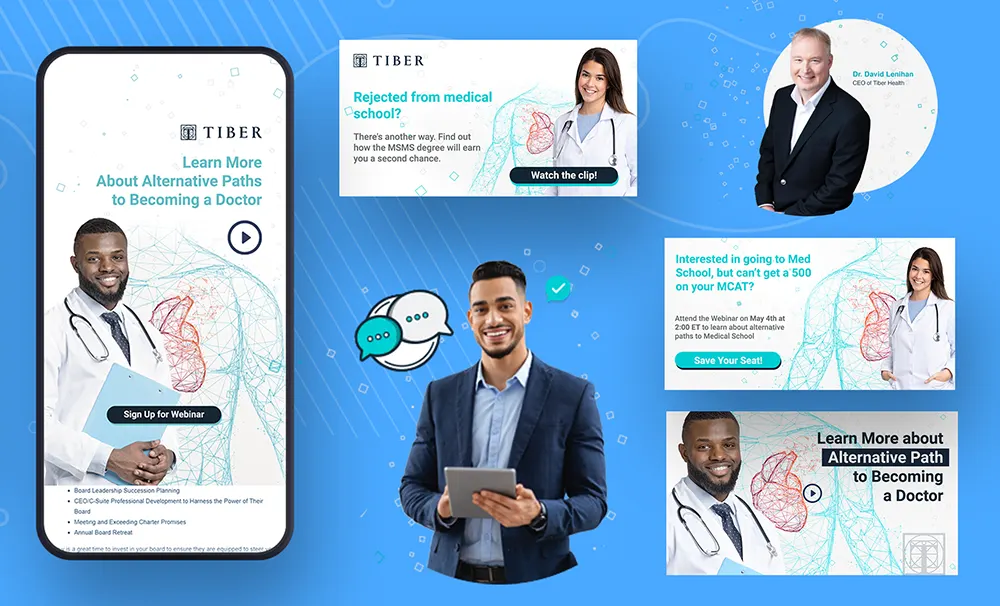
How to Repurpose Your Webinar Content: (Leverage + Amplify)

Most universities host webinars infrequently because they can be too burdensome on the staff and may not drive the needed results to warrant the workload to produce them. This is because most universities and colleges do not have a well-documented process and have not created the right promotional assets for the webinar. Keep reading as we’ll provide you with these tips below.
Plus, we can send you a copy of our go-to webinar blueprint for you to use with your next webinar!
Plus, check out our higher ed case study on webinars to see all that was created for Tiber Health to inspire you to create more engaging marketing pieces and slides for your next open house.
When producing content, you need to develop a strategy and blueprint to ensure you get the most value from these webinars. Most institutions would say their webinars were not a roaring success because the webinar is not utilized after the event is over.
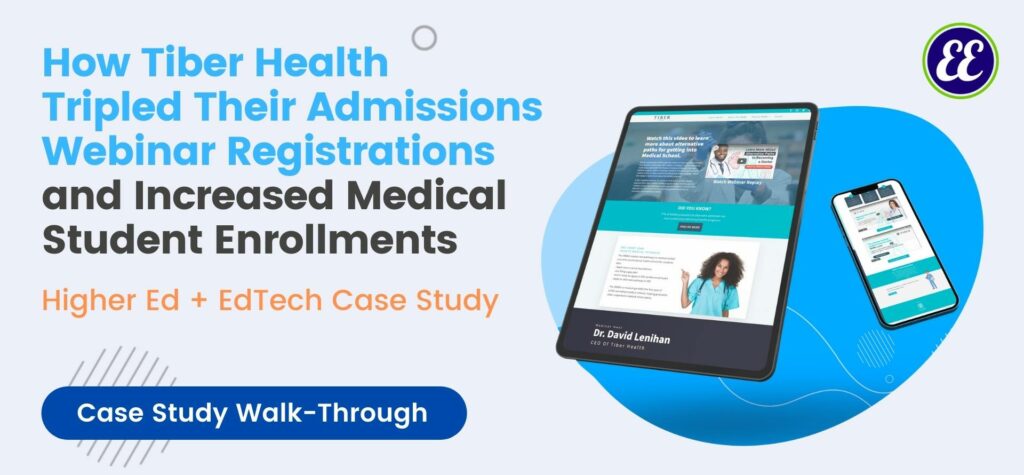
12. SEO for Universities: How to Increase Website Visitors and Enrollments?
For colleges and universities, optimizing a website for search engines has become an enrollment imperative. Higher education institutions need to rely increasingly on search engine optimization (SEO) to drive website traffic, where they can then convert visitors into prospective students, donors, and advocates.
A whopping 93% of online experiences begin with a search engine such as Google, Yahoo, or Bing. Forbes
Why Your University Should Invest in SEO
SEO encompasses several techniques to help improve the chances your Higher Ed website will appear on the first few pages of search engines like Google. While everyone’s goal is to become the #1 result on Google for terms like “bachelor’s degree”, “online degree”, and other similar phrases, it’s impossible for every institution to rank #1 for the most competitive search terms.
Dictionary.com defines SEO as “the methods used to boost the ranking or frequency of a website in results returned by a search engine, in an effort to maximize user traffic to the site.”
90% of pages receive zero organic traffic (source)
SEO is driven by the right keywords that prospective students would use to find your school or programs. Optimizing your website improves your chances of being found for those targeted phrases.
Search engines are the predominant source of website traffic, so incorporating these phrases or keywords into your copywriting is essential, but it’s only one piece of the pie.
SEO can potentially save your university money in the long run. – rather than paying for Google ads and display ads, a well-optimized website can increase your school’s enrollment success year after year.
Getting to page one of the search results is vital.
-
- 75% of users don’t even click past the first page!
-
- The first three organic search results get 60% of all traffic from a web search.
-
- Leads coming from a search have a 14.6% close rate, compared to just 1.7% from channels like print or direct mail advertising.
-
- 95% of new pages do not reach the first page of search results for the first year (Source)
Learn how to do perform your own University SEO Audit (read the blog)
Our agency is also offering a free SEO Audit

13. Improve Your College Landing Pages to Improve Your Paid Media Performance
Higher Ed landing pages best practices & examples
Paid media is a powerful channel for colleges and universities, but if you’ve been using it, you will have seen that the cost has increased significantly over time.
What used to be an easy, affordable way to get more interest for your school has turned into a competitive, often expensive endeavor. The keyword “entrepreneurship degree,” for example, can cost upwards of $51 for just one click!
To make that click worthwhile, you need to make sure as many of those clicks from Google to your landing page turn into inquiries and then into enrollments.
How to best leverage landing pages to drive more enrollments
This post will explore how you can leverage landing pages to help balance paid media costs. If your landing pages did a better job of converting visitors, then the same ad spend could result in up to double the return on investment you’re currently seeing through increased interest and enrollment.
What are Higher Ed landing pages?
Landing pages refer to the pages people are sent to after clicking on a paid ad. If you send someone to your homepage from a paid media ad, this acts as the ad’s landing page. However, using your homepage as a landing page is not the best practice.
Dedicated landing pages will help you create a targeted, highly relevant experience for the visitor, increasing the chance of conversions. Better performing landing pages differ from your standard webpage for a few reasons:
-
- They tend to be more segmented (focused on a single degree, campus location, modality) based on the ad’s content from which the visitors came.
-
- Landing pages are designed specifically for paid media conversion.
-
- Inquiry capture forms are prominently displayed, inviting conversion as quickly and easily as possible.
Unlike a website homepage, landing pages are customized to a specific campaign and guide visitors towards a call to action. In short, landing pages are designed for conversion rather than exploration.
Learn more about how Higher Ed Landing page and how they can help drive your college more enrollments while lowing costs.
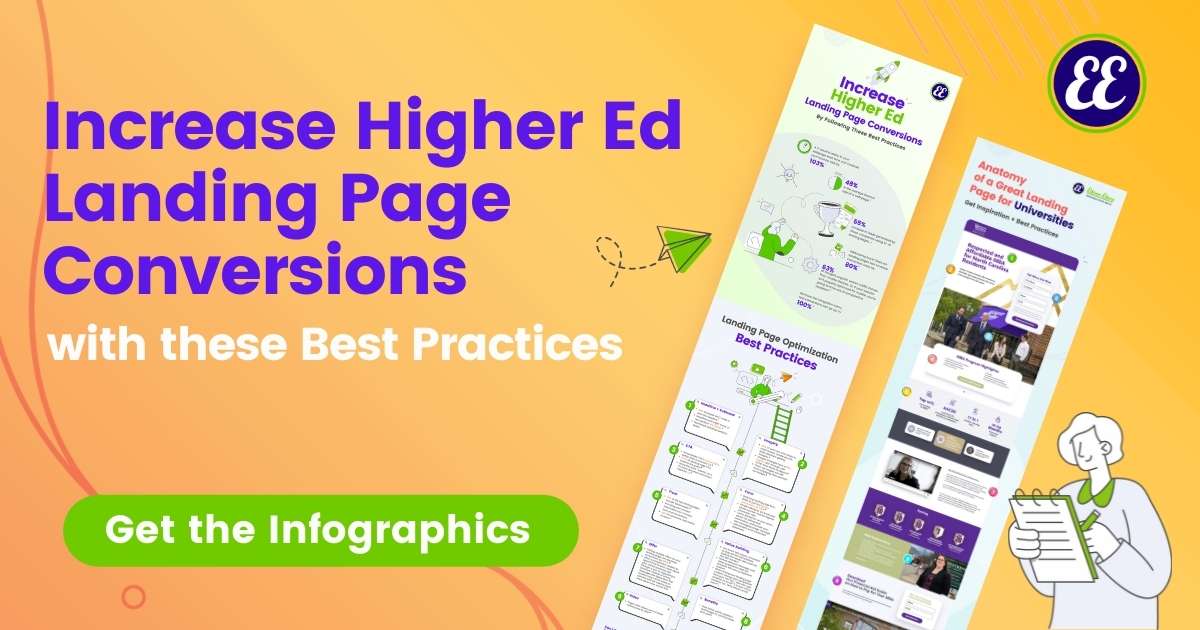
14. Improve Your Google Ads Performance with an Audit + What’s Changed with Google
If you’re looking at your Google Ads account with a sense of anxiety, you’re not alone. The platform can be overwhelming, and much like maintaining a home, it may seem like there’s always something that could use a little repair, tweaking, or freshening up. Knowing exactly how to make improvements and where to start the process might seem out of reach. But don’t worry — it’s not.
Whether you’re an agency account manager, part of an in-house team, or a small business owner handling your account, the following insights will help you improve your account structure, organization, and overall effectiveness. After you’ve finished reading, you’ll be on your way to making impactful account updates and tweaks that will lead to knock-out KPIs.
While the article below outlines all you’ll need to conduct a Google Ads audit on your own, there is a faster way to get great feedback on improving your account: Ellison Ellery provides complimentary audits.
Yes, you *heard* that right!
We do the work for you, thoroughly examining your bidding strategy, campaign efficacy, and profitability benchmarks against verifiable industry standards. If you would like our help, let’s get started! Request a Google Ads Audit by filling out a quick form, and one of our digital marketing experts will reach out with the next steps.
In this blog post on how to do a Google Ads audit, you’ll learn how to replicate this process independently.
Are Google Ads Worth It? To answer this, let’s consider a few statistics:
-
- Google Ads has a click-through rate of nearly 8%.
-
- Display ads yield 180 million impressions each month.
-
- For users who are ready to buy, paid ads on Google get 65% of the clicks.
-
- 43% of customers buy something they’ve seen on a YouTube ad.
-
- Most businesses see an average of 200% ROI on their Google Ad spend.
-
- Hundreds of thousands of companies use Google Ads to promote their businesses, which means that even if you’re ranking organically for a search term, your results are being pushed down the page, beneath your competitors.

15. Your University Value Propositions Need Love and Attention [Tips + Examples]
A universal truth of marketing is that messaging matters. This is even true at universities; maybe especially so. To stand out, you’ll need strong copywriting that clearly communicates what you offer and how it’s better than other universities.
Like any other business, universities can and must identify what makes them stand out from other universities – what makes them unique. This uniqueness is what we call your “value proposition.”
Why identify your university value proposition?
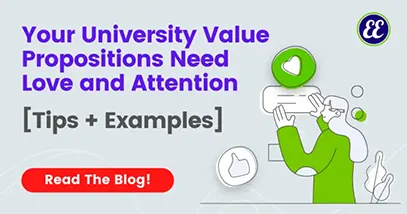
Having a clear and relevant value proposition matters because it articulates why a prospective student should come to your school over another school. It allows you to have clarity of message and easily communicate your value to a prospective student, which in turn should help you increase enrollment while reducing costs.
Without this clear message, there is nothing to help your school stand out from all the rest, making it more difficult to attract the kinds of students you want.
Clarity of message and value = Higher ROI
Ultimately, empowering your messaging with a unique value proposition results in a bigger bang for your buck when it comes to your marketing; you’ll have a better understanding of your audience and how to reach them, making each marketing effort that much more effective and improving the return on your marketing effort.
Read more about improving your university’s value propositions.
16. Improving Your Online Visibility with Local SEO
Increase your college’s local visibility and awareness with local SEO.
Find out why your college or university needs to proactively set up and manage your campus directory listings throughout the internet.
SEO is more cost-effective than paid advertising alone. As your website becomes more prominent in search results, it will gain visibility and attract more prospective students.
SEO is not meant to replace paid advertising, but it’s an added strategy to ensure your business brings in the right prospective students who can turn into future enrollments.
One way to improve your college or university’s visibility is to focus on local SEO. This is especially vital if your programs are on-ground or blended.
Keeping your campus location listings consistent and correct across the internet is the basis of local SEO.
Google Business Profile
As a starting point, have you claimed your Google Business profile? Should your college have a Google Business profile? Yes!!! Learn more about Google Business profiles.
Here is how to optimize your Google Business Profile.
Key Benefits of Local SEO for Colleges and Universities
-
- Reach more prospective students, especially local ones
-
- Improve brand awareness and visibility
-
- Find prospective students searching for your campus location and/or programs
-
- Increase your website traffic
-
- Improve your website conversion rates
-
- Bypass your competition (they may not know to optimize their local SEO giving you a competitive advantage)
How to Improve College Online Visibility through Local SEO (79 Local Online Directories).
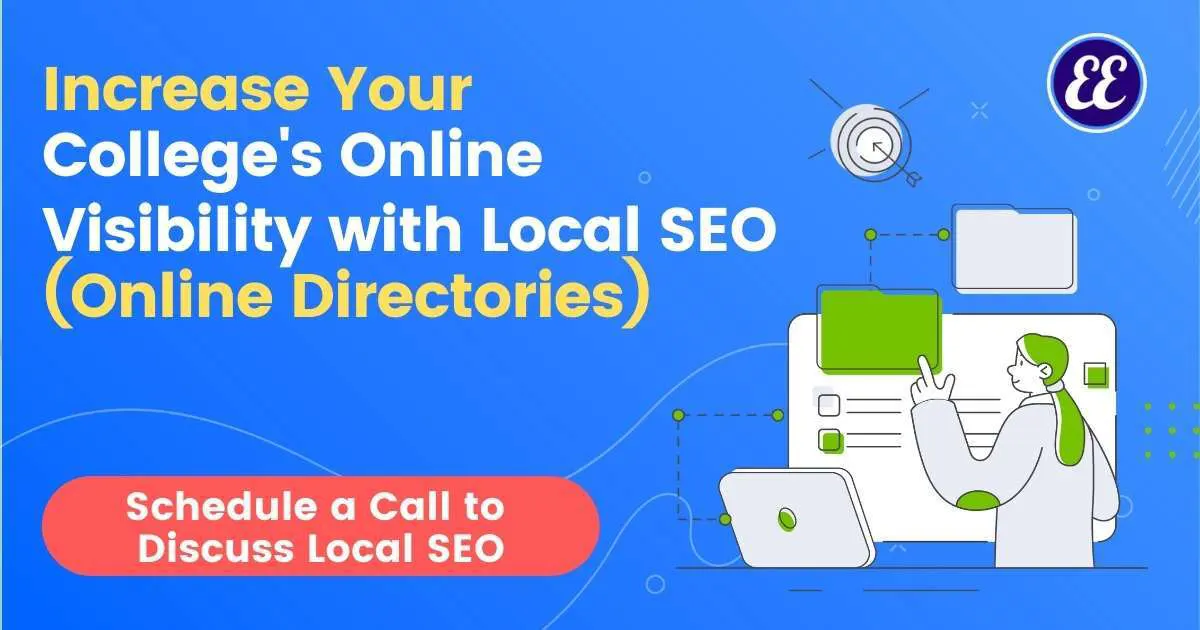
17. Student Journey Mapping and Enhancing the Student Experience
Higher Education Silos Contribute to Poor Student Experiences
Many colleges and universities break up their departments, which can create silos. As an unintended consequence of these silos, your student enrollment process may suffer. I often say silos are where great prospective students’ experiences go to die.
If you can align your communications and admissions departments around the idea of delighting prospective students with your enrollment experience, you should be able to grow your enrollments even in these turbulent times without growing your budget and costs.
We wrote an article to explain better the importance of creating an excellent enrollment experience. After you’ve mastered your enrollment experience, then you can start focusing on student onboarding to reduce your attrition and student drops. article shows you how you can improve your enrollment experience and increase enrollments without increasing your budget.
When is the last time your university updated its student personas, created student journey maps, or did student qualitative research?
With costs rising, it’s more important than ever to learn more about what motivates and drives your students to want to enroll at your university.
18. Is Your University Proactively Calling Prospects?
Have you ever stopped at a store and not been acknowledged by an employee while waiting to speak with someone? You know, when the store employees just go about their day without looking in your direction as you stand there waiting?
It’s frustrating! And if you don’t decide to persevere and make the employee hear you, you’ll probably just leave and find another store.
No matter how patient, everyone reaches a breaking point where they decide to move onto someone who will pay attention to them.
We do not realize how much friction is in our enrollment process until we walk through the process as prospective students. Has someone at your university requested information and gone through the entire enrollment process?
This scenario plays out across all industries, including Higher Ed and school enrollment processes. The time you take to respond to a prospect, also called speed-to-lead, matters.
See this photo below. This depicts what it’s like if prospective students request information from a few schools. Those schools may be set up to connect with the prospect immediately. Read on for tips on improving your enrollment process to serve students better, improve yield and grow tuition revenue.
To read more about the importance of calling your prospects.

19. Targeting Parents In Higher Ed: College Parent Facebook Groups & Other Must-Know Ideas
8 out of 10 parents are very involved in their child’s college planning process, but only half of the parents said they received communications specifically for them from colleges. Don’t let this be said about your college!
In an effort to help parents better manage their need to know what is happening on campus, colleges and universities have started creating parenting Facebook groups.
According to a piece by The New York Times, in 2019 more than 200,000 people joined university parent groups on Facebook in the U.S.
How Focusing on Parents Improves Your Enrollment Yield
So, here’s exactly why you should care:
Colleges may be able to increase student enrollment yield by as much as 30% by engaging parents in the admissions process!

It’s been shown that the more involved and supported a parent feels, the higher your yield will be. That’s why it’s so important for schools to focus on winning over both the student and the parent.
In this post we’re going to discuss 3 reasons why colleges should target parents, and provide 9 ways to engage parents more. As a quick preview:
The Top 3 Reasons Why Colleges Should Target Parents:
-
- There’s a better chance of admissions-related communications actually being viewed and acted upon.
-
- Student enrollment yield can be greatly increased (let the parent be your advocate!!)
-
- Involving parents ensures better retention rates.
Read more about how best to engage parents to increase your college’s enrollment.
In Summary
A lot has changed between 2020 and 2024.
While the higher education space has already been undergoing rapid transformation in the past decade, it is now more important than ever that your school learns to adjust for and adapt to your students’ new expectations and preferences.
Start replacing your traditional marketing strategies with timely, data-informed strategies. It’s time to modernize your marketing!
A great way to stay on top of the latest higher ed marketing trends is to attend conferences. We’ve put together a list of the most prominent higher ed conferences you should consider attending in 2025!
Our main takeaways from the top college marketing trends in 2024:
-
- Tracking is vital for all of your marketing + enrollment efforts
-
- Meet prospective students in the spaces they’re already at
-
- Learn how to act like a digital native
-
- Optimize your entire online enrollment experience
-
- Optimize your new student onboarding
-
- Host more interactive webinars, more often
-
- Improve your website’s SEO
-
- Audit your Google Ads accounts because there have been lots of changes that affect how you structure your accounts
Next Steps: Drive Enrollments With Good Marketing
Want to start implementing one (or more!) of these college marketing trends into your school’s marketing strategy but not sure how to start?
We can help. We’ve been in the higher education space for over 20 years and know the ins and outs of marketing and enrollment for higher ed.
If you’d like to learn more about how we can bring your project to life, schedule a quick introductory call so we can learn more about your school’s big ideas.


Modernize your enrollment process.
Schedule a free, no strings attached 30-minute consultation to find out how we can optimize your college’s enrollment journey and drive more qualified prospective students into your enrollment funnel.
